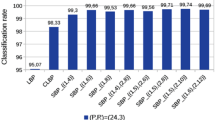Abstract
Humans recognize transformed images from a very small number of samples. Inspired by this idea, we evaluate a classification method that requires only one sample per class, while providing invariance to image transformations generated by a compact group. This method is based on signatures computed for images. We test and illustrate this theory through simulations that highlight the role of image structure and sampling density, as well as how the signatures are constructed. We extend the existing theory to account for variations in recognition accuracy due to image structure.






Similar content being viewed by others
References
Anselmi F, Leibo J, Rosasco L, Mutch J, Tacchetti A, Poggio T (2014) Unsupervised learning of invariant representations with low sample complexity. CBMM Memo No. 001, March 12
Cucker F, Smale S (2001) On the mathematical foundations of learning. Am Math Soc 39(1):1–49
Dow DM, Snyder AZ, Vautin RG, Bauer R (1981) Magnification factor and receptive field size in foveal striate cortex of the monkey. Exp Brain Res 44:213–228
Downing P, Jiang Y (2001) A cortical area selective for visual processing of the human body. Science 293(5539):2470–2473
Foldiak P (1991) Learning invariance from transformation sequences. Neural Comput 3(2):194–200
Fukushima K (1980) Neocognitron: a self-organizing neural network model for a mechanism of pattern recognition unaffected by shift in position. Biol Cybern 36:193–202
Grill-Spector K, Knouf N, Kanwisher N (2004) The fusiform face area subserves face perception, not generic within-category identification. Nat Neurosci 7(5):555–562
Kanwisher N (2017) The quest for the FFA and where it led. J Neurosci 37(5):1056–1061
Kanwisher N, McDermott J, Chun M (1997) The fusiform face area: a module in human extrastriate cortex specialized for face perception. J Neurosci 17(11):4302–4311
Liao Q, Leibo JZ, Poggio T (2013) Learning invariant representations and applications to face verification. In: Proceedings of advances in neural information processing systems (NIPS 2013), Lake Tahoe, NV
Tsao D, Freiwald W, Tootell R, Livingstone M (2006) A cortical region consisting entirely of face-selective cells. Science 311(5761):670–674
Author information
Authors and Affiliations
Corresponding author
Additional information
Communicated by Benjamin Lindner.
Appendix A: Some concepts from group theory
Appendix A: Some concepts from group theory
A group is a set G together with an associative binary operation on G which has an identity and such that each element has an inverse with respect to the operation. That is,
-
i.
For all \(a,b,c\in G\), it holds that \((a\cdot b)\cdot c=a\cdot (b\cdot c)\);
-
ii.
There exists an element e of G such that for all \(a\in G\), \(e\cdot a=a\cdot e=a\);
-
iii.
For every \(a\in G\), there exists \(b\in G\) such that \(a\cdot b=b\cdot a=e\).
Example
The integers are a group with respect to the operation of addition. The identity element is 0, and the inverse of a is \(-a\).
The action of a group G with identity e on a set X is a mapping from \(G\times X\) to X,
such that
and
Example
Let X be a two-dimensional disk centered about the origin. Define the rotation \(\phi \) as the operation which takes each point \(\left( {r,\theta } \right) \) of the disk to the point \(\left( {r,\theta +\phi } \right) \). The set of such rotations is a group which acts on X.
Suppose the group G acts on the set X. For each point \(x\in X\), the orbit of x is the set \(\left\{ {gx:g\in G} \right\} \).
Example
The orbit of the point \(\left( {r,\theta } \right) \) in the disk example above is the circle of radius r about the origin.
A computation on the elements of a set X is said to be invariant under the action of the group G if the result of the computation on an element x is the same as the result of the element gx for all \(g\in G\). In other words, if the results of the computation performed on any two elements of the orbit of x are indistinguishable.
Example
In the above disk example, consider the computation “distance from the origin.” The result of this computation is the same for all elements of any circle about the origin. That is, for all elements of the orbit of any point in the disk. Thus, this computation is invariant under the group action.
The simple examples above are given to illustrate the concepts. In the context of this paper, the set of interest will be a given set of images and the group action will be rotation of these images. The orbit of any particular image is in this case the set of all its rotations. A key idea is to find a computation (called a signature) which is invariant under this group action. This reduces the problem of distinguishing between different (potentially rotated) images to distinguishing between orbits of images, which is a much smaller set. This, in turn, drastically reduces the number of training samples required for certain image recognition tasks.
One final concept is needed. Given a group action G on a space X, the group G is said to be compact if its topology is compact. For example, if G is the set of two-dimensional rotations then G can be identified with the unit circle (if \(\phi \) is an element of G, then \(\phi \) can be identified with the element of the unit circle \(e^{i\phi })\), and the unit circle is a compact subset of the plane.
Rights and permissions
About this article
Cite this article
Roccaforte, R., Raudies, F. The effect of structure on image classification using signatures. Biol Cybern 112, 415–425 (2018). https://doi.org/10.1007/s00422-018-0761-2
Received:
Accepted:
Published:
Issue Date:
DOI: https://doi.org/10.1007/s00422-018-0761-2




